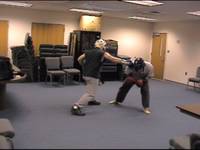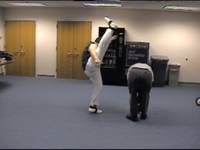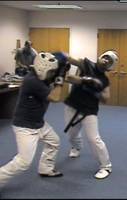We spent the beginning of the training working on the lateral/circular movement:
- Movement to the right, circling the opponent, jabbing, then when gaining positional advantage behind (7 or 8 o-clock position), loading up with both hands.
- Movement to the left, circling, jabbing, then when gaining positional advantage (1-5 o-clock position), loading up with both hands.
Then we worked the inside slip of the jab, and Sam drilled slipping inside with a simultaneous jab counter, then pivot to clear or load up, or slip inside with a simultaneous counter-right to the body, followed by the pivot to clear or load up. This went really well, though you didn't really try it later, it went well in the drills.
- Tips on this for Sam:
We discussed that when you move to the right, take smaller, but quicker steps, only 4-6 inches at a time with the right foot, then pivot and drag the lead foot into position. - As you slip to the inside, you HAVE to jab high and hard into the eyes/jaw/forehead to disrupt the right hand from taking you out. Otherwise you are walking into it.
- Both of those moves are too dangerous unless you pivot to get back into your defensive stance. Otherwise, positionally, you've just given everthing away.
We then handicap sparred
First round, jab only:
- Nathan started the round very aggressively, then the second half, was counter-fighting. Was effective at counter-fighting, not as much at leading off.
- Sam wasn't slipping or parrying very much, but was countering decently. He focused on turning over the punch for protection. Noticed you were moving in without leading much in this round. Also, throwing the short, low jab we discussed, too much. He was also working on the parry and catch, but was having problems with it.
- General observation: when Nathan is disrupting your rythme by moving to the right, plan for it and pump the jab as you step left, laterally cutting off the ring.
Next round we worked both hands, boxing:
- Sam started out with the same, ineffective low, short jab, then started to extend it, and double it up. Worked very well.
- Nathan was effective when leading off fast with 1-1-2, and pumping the jab to counter. When Sam came in without leading, Nathan was teeing off with punches from many angles, filling in the gap created by Sam leaving the centerline open.
- Sam's tactical objective was to lead-off with a combination, then get out. He said that goal was frustrated because Nathan was doing it first, and that he wasn't being aggressive enough.
- Sam: too much hanging out, or moving into range without firing the jab as cover.
- Recommend getting low, then jabbing into the eyes with the elbow up to cover.
Then two handicap rounds of, Sam left jab, Nathan, left hook.
- First round, Sam did a good job of keeping his right hand high to cover the hook. Longer jab and more movement would have kept the opponent away completely.
- First round, Nathan did OK when Sam stayed in range, but wasn't aggressive in slipping and coming in with the hook. Also, should work the double-hook a lot more.
- Second round, Nathan was more aggressive, and Sam was too, meaning that Sam was leading, but not clearing. Stick and move with a hooker(!).
MORE TO COME...










